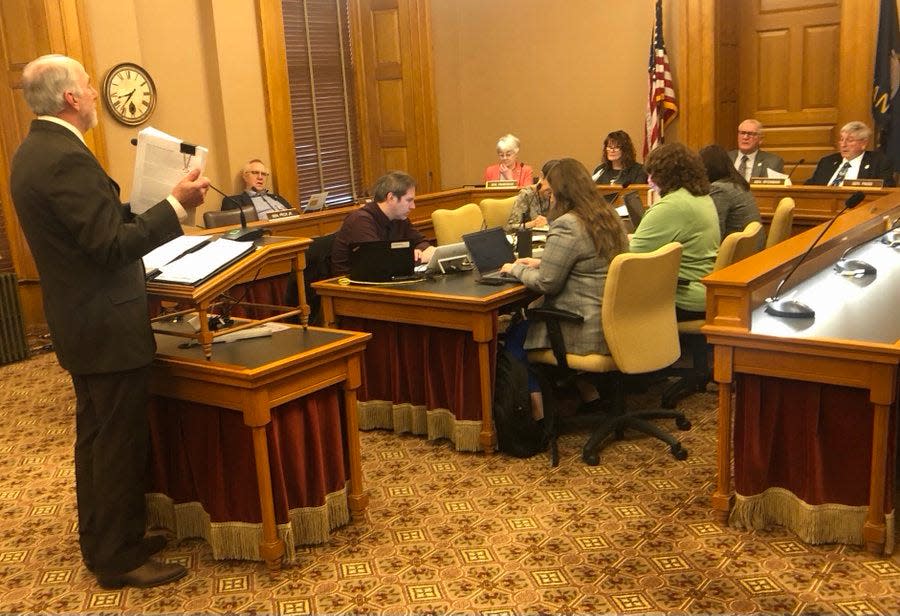Kansas among states with lowest percentage of public land for hunting, KDWP secretary says

Only two states offer a lower percentage than Kansas does of public land available for hunting and fishing, legislators were told Thursday morning.
"Our state is pretty shy on public lands," the Kansas Senate's Agriculture and Natural Resources Committee heard from Brad Loveless, secretary of the Kansas Department of Wildlife and Parks.
KDWP hopes to improve on that, he said.
Sen. Alicia Straub, R-Ellinwood, suggested residents could look at the matter "the opposite way" and instead appreciate that Kansas apparently has the third-most private land ownership among the states.
KDWP hopes to buy land in north-central Kansas
Loveless asked committee members to support enabling his department to buy a 264-acre tract the owner is willing to sell to it on the west end of Lovewell Reservoir in Jewell County in north-central Kansas.
Kansas law requires the passage of specific legislation for KDWP to acquire a tract that totals more than 160 acres, Loveless said.
The property would become available for public hunting, fishing, bird watching, mushroom hunting and wildlife habitat, he told The Capital-Journal after Thursday's hourlong committee meeting.
'I don't have places to go to hunt anymore like I used to'
KDWP conducts "a lot" of surveys on various topics, and ends each by asking for general comments, Loveless told committee members.
The most common comment respondents make is something along the lines of "I don't have places to go to hunt anymore like I used to," he said.
Loveless said Kansas has become "kind of the victims of our own success when it comes to deer hunting," with out-of-state hunters becoming increasingly willing to pay considerable money to lease property here upon which they can "come in and shoot a trophy Kansas deer."
KDWP doesn't begrudge those landowners from having a way to make money off their land, Loveless said.
Still, the "challenge becomes more complex" as a result in terms of providing public land, he said.
'More motivated than ever'
Public access is a top priority for KDWP, said Nadia Marji, chief of public affairs and engagement officer.
"It’s a long-standing issue, and one that has only grown more nuanced and challenging with time — especially in light of recent upticks in non-resident hunting participation," she told The Capital-Journal.
"That’s why KDWP is more motivated than ever to continue building upon, and improving, current access programs, as well as identify opportunities for strategic land acquisitions, where possible," Marji added. "It’s a challenge that won’t be solved overnight, and certainly without the support of partners and the Legislature. But it’s a challenge that can, and must, be overcome. Our residents deserve it, and our natural resources depend on it."
How much public land does KDWP own?
Currently, Marji said, KDWP can offer the public access to a combined 1,544,764 acres for outdoor recreation purposes.
That figure comprises of state-owned land, federally-owned land, and private lands enrolled in programs that allow public access, she said.
Of that 1,544,764 acres, just 127,587 acres are directly owned by KDWP in the form of wildlife areas, state fishing lakes and other lands considered public domain, Marji said. That's less than 1%, she said.
The majority of the remaining acreage is held in private ownership, with 295,719 acres being federally owned, she said.
Those figures do not include Kansas state parks and/or county-, city- or community-owned areas open to public access, Marji said.
Public access programs
Loveless also talked at Thursday's meeting about public access programs KDWP makes available.
The best way for the public, including landowners, to learn about public access programs in Kansas is by accessing the Kansas Hunting and Furharvesting Regulations Summary, Kansas Hunting Atlas, Kansas Fishing Regulations Summary and/or the Kansas Fishing Atlas, Marji said.
These publications are offered in print at most license vendor locations and major outdoor retailers, as well as all KDWP offices, she said.
Contact Tim Hrenchir at threnchir@gannett.com or 785-213-5934.
This article originally appeared on Topeka Capital-Journal: Kansas is 'pretty shy on public lands,' state Senators told

